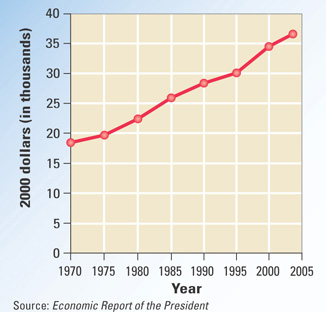Section 3 Economic Growth
Preview
Objectives
After studying this section you will be able to:
- Analyze how economic growth is measured.
- Understand capital deepening and how it contributes to economic growth.
- Analyze how saving and investment are related to economic growth.
- Summarize the impact of population growth, government, and foreign trade on economic growth.
- Identify the causes and impact of technological progress.
Section Focus
Economic growth is a steady, long-term increase in a nation's real GDP that tends to raise living standards. Primary contributors to long-term growth include capital deepening, saving and investing, and advances in technology. The other factors that affect economic growth are population, government, and foreign trade.
Key Terms
- real GDP per capita
- capital deepening
- saving
- savings rate
- technological progress
Most of us would agree that as far as material possessions go, Americans are much better off today than they were 100 years ago. Why is this so?
Economic growth has allowed successive generations to have more and better goods and services than their parents. Long-term increases in real GDP allow an entire society to improve its quality of life, especially its standard of living. (See Chapter 3.)

Image Long Description
Figure 12.11 Real GDP per Capita, 1970–2004
A hundred years ago, most American families would have been able to own an icebox, a wood-burning stove, and a horse or bicycle. For most of us today, those necessities of life have turned into a refrigerator-freezer, a microwave oven, and a car or two. Think about the differences between these two sets of products!
Measuring Economic Growth
The basic measure of a nation's economic growth rate is the percentage change of real GDP over a given period of time. For example, the real GDP in 1994 was $7.8 billion, and in 2004, it was $10.8 billion. The economic growth rate for this decade was about 38 percent (($10.8 billion − $7.8 billion) ÷ $7.8 billion × 100).
GDP and Population Growth
Over time, a nation's population tends to grow. Real gross domestic product, if it is to satisfy the needs of a nation's growing population, must keep up with the growth rate of the population.




